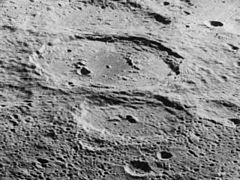
Anaximenes is a low-rimmed lunar impact crater near the north-northwest limb of the Moon. It lies to the west of the crater Philolaus, and northeast of Carpenter. To the northwest is Poncelet, close to the visible edge of the Moon.
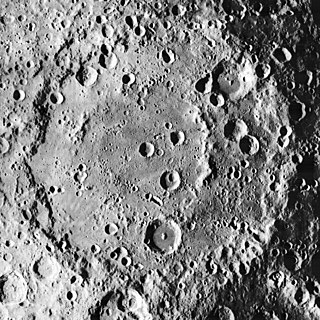
Korolev is a large lunar impact crater of the walled plain or basin type. It is a basin of Nectarian age.
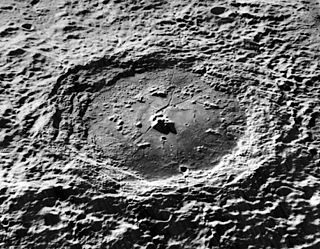
Compton is a prominent lunar impact crater that is located in the northern hemisphere on the far side of the Moon. It lies to the east of the Mare Humboldtianum, and southwest of the walled plain Schwarzschild. To the southeast of Compton is the heavily eroded crater Swann.

Lemaître is a lunar impact crater that is located on the southern hemisphere on the far side of the Moon. It lies to the south of the older crater Minkowski, and north of Crommelin. To the east-southeast lies the crater Eijkman.

Cusanus is a lunar impact crater that is located near the northeastern limb of the Moon. In this location the crater appears very foreshortened when observed from the Earth, and its visibility is affected by libration. The northern rim of Cusanus is nearly joined to the south-southeastern rim of the larger crater Petermann. To the west is Baillaud and to the southeast is Hayn.

Demonax is a lunar impact crater near the southern limb of the Moon. This location makes the crater difficult to observe due to foreshortening. The crater is also illuminated at a very low angle, when it is in the sunlit side. Demonax lies just to the north of the crater Scott, one of the south polar formations. To the north-northwest is Boguslawsky.
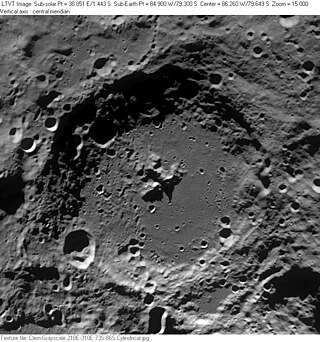
Drygalski is a large lunar impact crater that lies along the southern limb of the Moon. It partly overlies the crater Ashbrook to the west on the far side of the Moon. Just to the north of Drygalski is the smaller Boltzmann. The location of this crater restricts its observation from the Earth, and even under conditions of favorable libration it is viewed from the edge. It is only illuminated by the Sun at an oblique angle, and it lies close to the south polar craters that are permanently shielded from sunlight.

Chebyshev is a large lunar impact crater that lies in the southern hemisphere on the far side of the Moon. The somewhat smaller crater Langmuir is intruding into the east-southeastern rim of Chebyshev, forming a chain of large craters with Brouwer on Langmuir's eastern rim.

Clairaut is a lunar impact crater that is located in the rugged southern highlands of the Moon's near side. It lies directly to the south of the crater Maurolycus and southeast of Barocius. Just to the southwest is Cuvier.

Campbell is a large lunar impact crater that is located in the northern hemisphere on the far side of the Moon. It lies to the southwest of the walled plain D'Alembert, an even larger formation. If Campbell were located on the near side of the Moon as seen from the Earth, it would form one of the largest visible craters, being slightly larger than Schickard. It is bordered by several craters of note, with Wiener to the southwest, Von Neumann just to the south, Ley overlying the southeast rim, and Pawsey to the west.

d'Alembert is a large lunar impact crater located in the northern hemisphere on the far side of the Moon, to the northeast of the somewhat smaller walled plain Campbell. Astride the southwest rim of d'Alembert is Slipher. To the north is the crater Yamamoto, and to the south-southwest lies Langevin. This walled plain has the same diameter as Clavius on the near side, making it one of the largest such formations on the Moon.
Cooper is a lunar impact crater that is located in the northern hemisphere on the far side of the Moon. It lies to the east of the large walled plain D'Alembert, and west-southwest of the crater Chappell.

Coriolis is a lunar impact crater that is located on the far side of the Moon. The crater floor is bisected by the lunar equator, and it lies about three crater diameters northwest of the crater Daedalus.

Dyson is a lunar impact crater, 63 kilometers in diameter, that lies on the far side of the Moon, past the northwest limb. It is located in the northern part of the surface, to the northwest of the crater Coulomb, and east of van't Hoff.

Chalonge is a lunar impact crater that is located on the far side of the Moon. It lies to the southwest of the larger crater Lewis, in the outer skirt of ejecta that surrounds the Mare Orientale impact basin. To the southeast are the Montes Cordillera, a ring of mountains that encircle the Mare Orientale formation.

Donner is a lunar impact crater on the far side of the Moon. It is located just to the northeast of the Mare Australe, behind the southeastern limb of the Moon. During favorable librations this part of the lunar surface can be brought into view of the Earth, but the site is viewed from the edge and so not much detail can be seen.
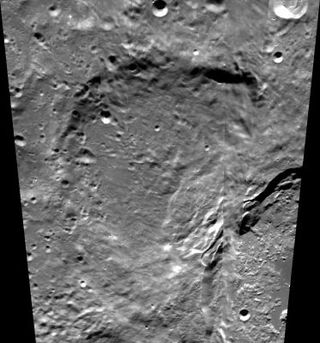
Minnaert is a large lunar impact crater that is located on the far side of the Moon, deep in the southern hemisphere. It is partly overlain along the southeastern side by the larger and younger crater Antoniadi. To the west-northwest lies Lyman.

Numerov is a lunar impact crater that is located on the Moon's far side, deep in the southern hemisphere. It is attached to the larger and younger crater Antoniadi to the west, and the outer rampart of Antoniadi overlies the inner wall and part of the western interior floor of Numerov. To the east-southeast is the larger walled plain Zeeman, and to the east-northeast is the old crater Crommelin.

Kleymenov is a crater on the far side of the Moon. It is located near the east-northeastern outer wall of the huge walled plain Apollo, and to the west-northwest of the large crater Chebyshev. To the north is Mariotte.
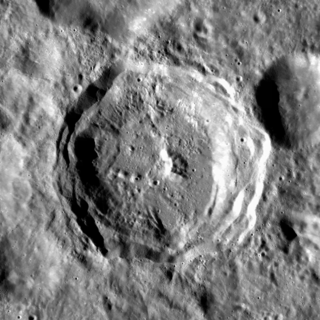
Nušl is an impact crater that is located on the far side of the Moon. It lies just to the north of the crater Trumpler, and to the west of Shayn.


